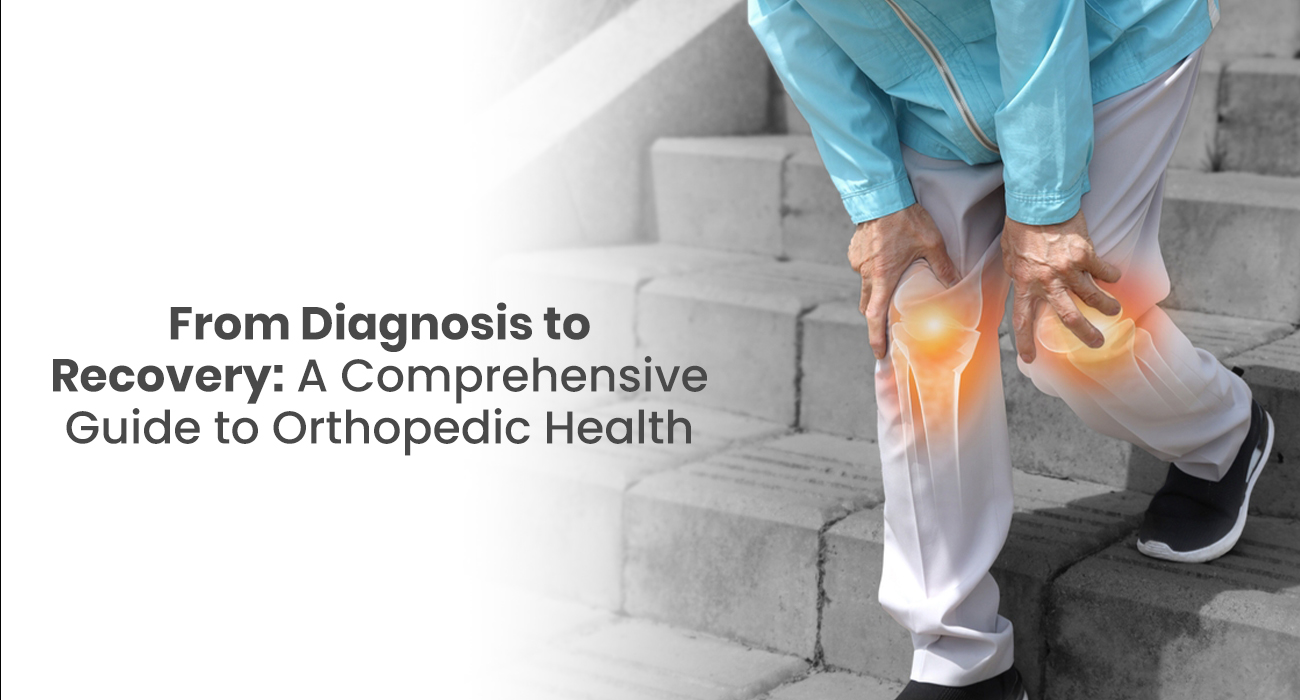From Diagnosis To Recovery: A Comprehensive Guide To Orthopedic Health
07/16/2025
Orthopedic health is critical to our ability to move, our ability to perform daily activities, and our ability to remain pain-free. A sprained ankle, arthritic knee, spinal issue, or complex hip replacement are all but a few examples of orthopedic conditions, which may affect the quality of our lives.
What is Orthopedic Health?
Orthopedic health is the health of your bones, joints, ligaments, tendons, and muscles — in short, the entire musculoskeletal system. The system enables you to move, stand, sit, and perform activities ranging from easy to challenging.
Healthy joints are not just vital for athletes or elderly people, but for everyone. Among the most prevalent orthopedic conditions are:
- Joint and arthritis pain
- Injuries from sports (like ACL injuries, sprains)
- Neck and back pain
- Osteoporosis
- Dislocations and fractures
- Degenerative diseases like osteoarthritis
Early Warning Signs of Orthopedic Complications
Timely diagnosis can prevent complications and speed up healing. Watch out for these warning signs of early onset:
- Recurrent joint or muscle pain
- Swollen or painful joints
- Stiffness, especially in the morning
- Difficulty walking, bending, or lifting
- Numbness or tingling in arms or legs
- Frequent joint popping or grinding
Knee pain diagnosis and treatment or hip pain recovery early is important to prevent long-term disability or surgery.
How Orthopedic Conditions Are Diagnosed?
To diagnose an orthopedic condition your doctor will:
1. Medical History and Physical Examination
Your orthopedic physician will inquire about the place, time, and character of the pain. Your orthopedic physician may also inquire about past injuries or conditions such as diabetes that can influence bone healing.
2. Imaging Tests
X-rays are used to identify fractures or arthritis.
MRI scans reveal soft tissue injuries (such as ligaments or cartilage injury).
CT scans give a close-up view of intricate bone anatomy.
Bone scans or DEXA scans are used in detecting osteoporosis.
3. Blood Tests
For some cases, especially in the case of suspected infection or arthritis, blood is drawn for screening for inflammatory markers or auto-immune conditions.
Common Orthopedic Conditions and How They Are Treated
Some most common orthopedic conditions are:
Knee Pain
Knee pain is one of the most frequent orthopedic complaints, especially in people over 40 years old or athletes. Causes are:
- Osteoarthritis
- Meniscus injury
- Sprains of the ligaments (ACL, MCL)
- Patellar tendinitis
Treatment can be by physiotherapy, bracing, anti-inflammatory medication, and in extreme cases, replacement surgery within the knee.
Hip Pain and Recovery
Hip pain is often caused by arthritis, bursitis, fractures, or labral tears. The following are non-surgical treatments:
- Physical therapy
- Corticosteroid injections
- Anti-inflammatory medication
In case of a serious condition, hip replacement surgery may be recommended. Most patients regain full mobility with proper orthopedic rehabilitation.
Spine Health and Recovery
Back pain may be caused by herniated discs, degenerative disc disease, spinal stenosis, or poor posture. Maintaining the health of the spine is essential in order to avoid compression of nerves or chronic pain.
Treatment Options:
- Physiotherapy and exercise to strengthen muscles
- Pain control measures
- Spine surgery (when conservative treatments fail) that involves minimally invasive techniques
Recovery would take weeks or months depending on the condition and treatment performed.
Types of Orthopedic Treatment: Surgical and Non-Surgical Plans
Orthopedic treatment includes both surgical and non surgical plan depending on the condition of the patient.
Non-Surgical Orthopedic Treatment
Most of the orthopedic problems can be managed non-surgically, if diagnosed in the early stages. Some of the popular conservative measures are:
- Medications
- Physiotherapy for strengthening and mobilization
- Joint injections to reduce inflammation
- Aids like braces, orthotics, or canes
- Weight reduction, posture correction, and modification of activities
Surgical Orthopedic Treatment
- Surgery is indicated when:
- Non-surgical approaches fail
- The condition severely disables mobility or leads to disability
- There is a structural deformity or traumatic injury (e.g., fractures)
- Permanent damage to the joint
Common Orthopedic Procedures
- Knee Replacement
- Hip Replacement
- Spinal Fusion
- Arthroscopy (minimally invasive joint surgery)
- Rotator Cuff Repair
- Fracture Repair by Plates, Rods, or Screws
Each of these has its own particular orthopedic surgery recovery process, usually including rest, physical therapy, and return to activity gradually.
Orthopedic Surgery Recovery: What Happens
Recovery varies with the surgery type and patient's age, health, and physical fitness. But following are general recovery milestones:
1. Recovery in Hospital
Recovery from hospital may vary between one day and a week
Ease in pain with medication
Dressing of the wound and prevention of infection
Physiotherapy gets started early within 24–48 hours
2. Rehabilitation Phase
It is the most critical phase of the recuperation.
Orthopedic rehabilitation is done through guided physical therapy
Range-of-motion exercises and strengthening
More and more return to walking, stair climbing, and activities of daily living
Avoid high-impact exercises until clearance by your doctor
3. Full Recovery
Joint replacement patients recover in 6–12 weeks
Spinal procedures recover fully in 3–6 months
Periodic exercises, proper weight, and joint care avoid relapse
What is the Role of Orthopedic Rehabilitation?
Orthopedic rehabilitation is a structured recovery process applied to restore the function, flexibility, and strength after surgery or injury.
It:
- Decreases stiffness and pain
- Prevents formation of scar tissue
- Restores a normal joint range of motion
- Helps you become independent once again
Rehabilitation courses are tailored. For example, recovery of back health and recovery rehab is quite distinct from recovery of hip pain.
Lifestyle Tips Towards Better Joint and Bone Health
Even when healing takes place, orthopedic health should be upheld. Here's how:
1. Stay Active
Perform low-impact activities like swimming, walking, or cycling to maintain flexibility of joints and tones of muscles.
2. Eat for Your Bone Health
- Eat a calcium, vitamin D, and protein-rich diet to have healthy bones. Include:
- Leafy vegetables, milk and dairy products, fortified cereal
- Eggs, lean meat, legumes
- Omega-3 foods like walnuts and fish (for joint lubrication)
3. Stay at a Healthy Weight
Being overweight places additional stress on joints, especially knees, hips, and the spine. Even minimal weight loss can reduce pain and slow the degeneration of joints.
4. Use Ergonomic Devices
Use back supportive chairs, sit properly at workstations, and wear good shoes to protect your joints and spine.
5. Don't Fall and Get Injured
In bathrooms, put in grab bars, have good lighting, and avoid slippery floors — important for older persons and post-surgery recovery patients.
When to See an Orthopedic Specialist?
Don't wait until the pain. See a specialist if:
- Pain exceeds several weeks
- Feeling pain every day when performing daily activities (walking, sitting up stairs)
- There is swelling, deformity, or bruising that can be seen
- You hear crunching or popping sounds within joints
- There is pain in your back and radiating to your legs or numbness in your arms
Conclusion
Orthopedic treatment is more than bones — it's about your quality of life, your capacity to live life to the fullest, move with ease, and engage in your day-to-day activities without pain. From diagnosis to full recovery, having control over your orthopedic health through timely intervention, accurate treatment, and ongoing rehabilitation can dramatically improve your quality of life.
Whether knee pain diagnosis and treatment, hip pain recovery, or spine health and recovery, your orthopedic experience doesn't end in surgery — it ends when you're on your feet, healthier than ever before.
Implement small adjustments today to protect your joints, stay active, and seek help early. Your bones will thank you tomorrow.



 +91-9166096099
+91-9166096099